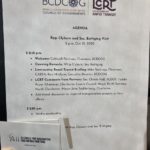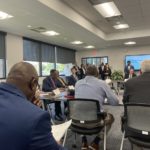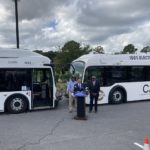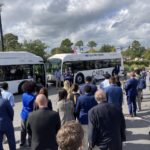U.S. Department of Transportation Secretary Pete Buttigieg has been on a tour touting the Infrastructure Investment and Jobs Act that will lead to billions of dollars in infrastructure spending across the country. His latest stop was the lowcountry of South Carolina. Meeting with local leaders and visiting key infrastructure assets, the Secretary was hosted by U.S. House of Representatives Majority Whip, Rep. Clyburn (D-SC).
The Charleston metro area is one of the most dynamic infrastructure hubs in the country owing to its maritime ports, extensive rail network, trucking and logistics operations, and joint naval-air base. Boeing, Bosch, Ingevity, and a host of manufacturers, energy companies/utilities, and many others also contribute to the economy, supply chain, and critical transportation and infrastructure features.
After touring the South Carolina Ports and before visiting the Charleston International Airport, Sec. Buttigieg joined a veritable who’s who of local government officials and transportation professionals at the Berkeley-Charleston-Dorchester Council of Governments (BCDCOG) building for an update on a new rapid transit line in the tri-county area.
After introductions by the chairman of the BCDCOG, Rep. Clyburn, and Sec. Buttigieg, the event included updates and remarks by local councilman and chairman of the Charleston Area Regional Transportation Authority (CARTA), Mike Seekings. Seekings provided a historical overview of transportation and population changes in the Charleston area since the early 1900s, noting that in 1929 over 15 million distinct trips took place on streetcars on the historic peninsula of Charleston. He carefully noted that these were privately operated, not publicly supported transit operations and that this was before the advent of widespread personal automobile ownership.
Following Seekings, Ron Mitchum spoke in his capacity as the executive director of the BCDCOG. His presentation was far more technical and included updates on a number of infrastructure and transportation projects in the area. Central to the day’s event, however, was the new Lowcountry Rapid Transit (LCRT) line. As was pointed out by the South Carolina Department of Transportation Secretary, Christy Hall, the LCRT is the first and largest public transit system in state history.
This transit line will feature 19 new all-electric buses, 20 new modern stations (including three park-and-ride locations), and span some 21.3 miles from Ladson, SC to seven stops within the historic downtown Charleston peninsula. While the project has moved beyond its local planning stage (completed in 2016), project programming (completed in 2019), and project development (completed in 2022), the LCRT route is currently in a multi-year engineering phase. Construction is expected to begin in 2026 and extend through 2028. The project is expected to service 2.25 million annual trips by 2040.
During the event, local leaders explained that the population of residents on the peninsula is around 30,000, yet every day workers and tourists double the population in this limited downtown area. Just over 7,000 hospitality, cleaning, and other workers commute in, while over 21,000 tourists and other visitors also arrive. The LCRT fleet of electric buses are expected to facilitate this – without straining limited parking availability on the peninsula.
With Seekings pointing out the private nature of street cars and other transit services in the last century, and the vastly higher ridership numbers, it remains to be seen how the publicly-supported bus route will thrive or flounder as it takes over a decade to reach its projected ridership of only 2 million annual riders. Moreover, that ridership spans a 21-mile route and multiple cities, while the previous record ridership year was only within the few-mile stretch of the peninsula itself.
Overall, leaders from mayors to city councilmen and others spoke highly of the LCRT and secondarily on the importance of partnerships and collaboration on infrastructure topics. Secretary Buttigieg made a particular point to laud this collaborative approach. The Secretary then spoke at a press conference in front of two electric buses, highlighting billions of dollars that Congress is allocating to projects like this around the country.
Written by Benjamin Dierker, Director of Public Policy
The Alliance for Innovation and Infrastructure (Aii) is an independent, national research and educational organization. An innovative think tank, Aii explores the intersection of economics, law, and public policy in the areas of climate, damage prevention, energy, infrastructure, innovation, technology, and transportation.



